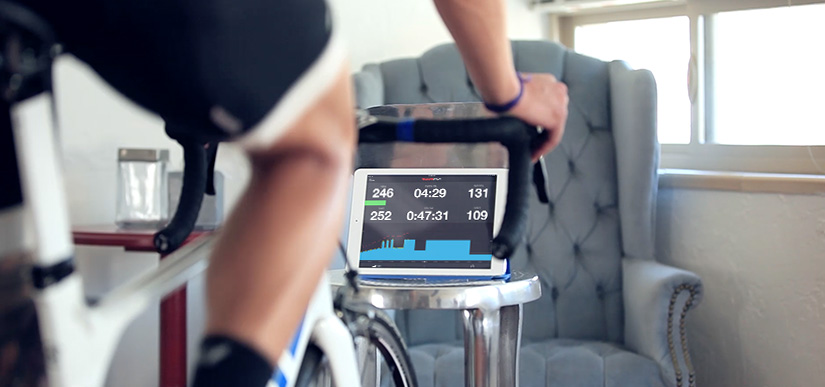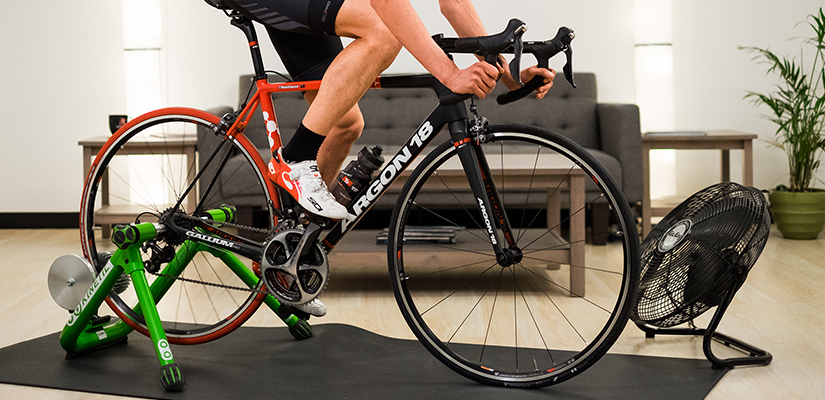FTP Testing: Tips & Strategy to Prepare for Your Next FTP Test

Whether you’re new to riding with power or highly versed in the ways of watts, FTP testing is one of the more important aspects of power-based training. When an athlete gets started cycling training, the first workout is usually an FTP test. There’s a fundamental reason for this. It gives you a current snapshot of your fitness so that your workouts won’t be too hard or too easy. They’ll be just right for your current fitness level while still pushing you the right amount to help you achieve your fitness goals.
For more FTP Test Tips, check out Ask a Cycling Coach Ep 249.
FTP tests take a bit of skill and practice to accurately assess your fitness. Fortunately, TrainerRoad’s Ramp Test makes testing FTP much simpler. Even better you can skip it altogether with AI FTP Detection If you are testing outside or using a traditional FTP test, you’ll unlikely nail it the first time. Most athletes don’t—and that’s okay! With this guide, our goal is to help decrease the learning curve many riders experience the first time they do an FTP test.
Table of Contents
What is FTP?
Functional Threshold Power, or FTP, is the foundation for all your power-based workouts. In essence, it’s the measure of your highest sustainable power for an extended duration. In theory, it’s supposed to represent the maximum power you can sustain for an hour. But in the real world, riding at this power is challenging. Many cyclists have trouble maintaining it for much longer than 30 minutes.
Physiologically, FTP is analogous to Lactate Threshold. This is when your lactate production has risen and leveled off, closely matching your lactate removal ability. Sustaining high efforts for durations of this length pushes you into that grey area between the power you can sustain all day and the fleeting power you can only tolerate for a couple of minutes.
What is an FTP Test?
An FTP test is a physical assessment intended to evaluate your Functional Threshold Power. During the test, you attempt to sustain the highest workload you can for a specific amount of time. An estimate of your FTP is calculated from your power output. From this result, your workouts are tailored to your current fitness.
Types of FTP Tests
Since FTP is supposed to represent the power you can sustain for an hour, the most obvious way to test FTP is to ride as hard as you can for 60 minutes and measure your average power. This is extraordinarily difficult to pace correctly and incredibly fatiguing in practice, so most testing protocols use approximations derived from shorter efforts.
Adaptive Training
Get the right workout, every time with training that adapts to you.
Check Out TrainerRoadTrainerRoad’s preferred FTP test is our Ramp Test. The Ramp Test begins with a 5-minute warmup, and then every minute after that, it gets slightly harder until you cannot maintain target power any longer. 75% of your best one-minute power during the test is used as your FTP. Our data shows the Ramp Test results in the most accurate and useful FTP estimate for the majority of cyclists using TrainerRoad. Since it is quick (normally about 25 minutes, including warmup and cooldown) and less stressful, it can be taken frequently to track changes in your fitness.
Perhaps the best-known FTP testing method is a 20-minute time trial. In this format, you ride as hard as you steadily can for 20 minutes; 95% of your average power during this interval is used as your FTP. Another common method is the 8-minute test, in which you ride two 8-minute intervals with 10 minutes of rest in between. In this format, your FTP is derived as 90% of the overall average power of the two efforts. TrainerRoad offers both of these tests as options, but they are more subject to pacing, fatigue, and equipment challenges than the Ramp Test.
How To Do an FTP Test
Doing an FTP Test isn’t difficult on the surface. However, they are challenging to execute because they require digging deep with proper pacing. Before you attempt one, it’s helpful to understand the details of each testing format.
20 Minute FTP Test
The goal of the 20-minute test is a steady-state effort—one that sees minimal fluctuations in power output. It will take an hour, including a warmup and cooldown. Pacing a 20-minute FTP test is crucial. This is a strenuous effort, so make sure you’re well-rested.
Begin with a warmup for 30 minutes, and don’t be afraid to throw in a few short steady-state efforts. Once you’re ready, start your test. If you’re doing it outside, hit the lap button on your head unit when you start and finish. It should feel like you are trying to sustain your highest power without blowing up. Your FTP is 95% of the average power of the interval.
How To Pace a 20 Minute FTP Test
From the start, build your power quickly but controlled, then hold it high and steady. Avoid large surges near the finish, which can artificially lift your power number, skewing your results. The simplest advice is don’t go out too hard. At the same time, you don’t want to go out too easily.
We recommend riders reassess their pace every 5 minutes during the test, and that any adjustments be just a few percent at a time. Many athletes ride these long efforts too conservatively and surge their power during the last 2 minutes; this skews the results and should be avoided. You should arrive at the last 5 minutes just able to hang on and maintain steady power.
When pacing a 20-minute FTP test, pay close attention to how you’re feeling during the last 5 minutes of your test. If you paced accordingly, you should be just hanging on. If you’re able to elevate your effort substantially at the end, it’s a sure sign you didn’t pace well.
8 Minute FTP Test
Similar to the 20-minute test, this version still includes a thorough warmup and cooldown. The primary difference is that you’ll complete two efforts at higher power. Your FTP is 95% of the average of both efforts.
How To Pace an 8 Minute FTP Test
The individual efforts of the 8-minute test should be harder than that of the 20-minute FTP test and should represent power at VO2max. However, like the 20-minute test, these efforts should be as steady as possible. Power data for perfect execution of the 8-minute test will result in two efforts that look like subtle smiles, with a slightly higher output during the beginning and end of each interval and a steady effort during the middle. If you have a dramatic spike at the beginning or end, it’s an indication of bad pacing.
Reassess your effort every 2 minutes during the 8-minute test, but any pacing adjustments should be subtle. The 2 efforts should be as similar as possible, if your second interval is much weaker than the first it’s a clear sign you started too hard.
Ramp Test
The beauty of the Ramp Test is that it requires no pacing strategy. Instead, the key is to absolutely empty the tank. Follow the intended target power as close as possible for as long as you can. Even a few seconds more when you think you are done can yield meaningful data, so you should ride until you physically can’t maintain power anymore. You should not make the conscious choice to stop- instead, your legs should override your brain.
You don’t need to do any openers prior to starting your Ramp Test. While doing some openers is a great way to prepare your system for hard efforts psychologically, we intentionally designed the Ramp Test not to require any additional preparation. You also don’t need to do an extra warmup before you start the Ramp Test; we’ve tested and found it did not alter the results in a meaningful way. The first five minutes are naturally very easy and will prepare you for the harder efforts.
Why Test Your FTP?
The estimate you obtain from an FTP test is used to calibrate your training zones and set the intensity of your workouts. Without actually testing your Lactate Threshold and VO2max in a lab, your FTP is an approximation. But, the applicability and usefulness of this number has been proven by generations of coaches and endurance athletes.
Because we use this measure of fitness as the basis for all of your training, it’s important that this number estimates your actual sustainable-power threshold as closely as possible. This is why it is important to test your FTP and test it often. Testing repeatedly over time tracks changes in your fitness, allowing your workouts to be calibrated to your current abilities.
When To Do an FTP Test?
Generally, FTP tests are best done at the beginning of each training block— about every 4-6 weeks. This allows enough time to catch any fitness changes. Additionally, if you’ve taken an extended break from training, it’s a good idea to start with a test. Every TrainerRoad training plan automatically includes the Ramp Test for each training block
If all of this seems overwhelming, you’re not alone. Many cyclists find testing cumbersome and draining. With Adaptive Training, you can use AI FTP Detection. This feature replaces the need to test. It uses AI to analyze your training progress, relative strengths, previous experience, and many other factors to give you an informed and data-backed FTP.
FTP Testing Tips
- Aim for consistency. Your preparation for your test should be the same as for any other workout. Calibrate your power meter, maintain your usual cadence, and hydrate and fuel like you normally would. Use the same equipment and setup for each test so the only variable changing is your fitness.
- Accuracy is your goal. Getting an accurate FTP is more important than getting a new personal record. Although it would be difficult to do so anyway, “gaming” the test wouldn’t offer you any benefits, as the result would be inapplicable to training.
- Test frequently. Our training plans include Ramp Tests every 4-6 weeks, but whatever protocol you choose it’s good to test regularly to track changes in your fitness.
- Be rested. Testing when exhausted or not recovered from a hard ride will not reveal accurate results.
- Fuel Up. Eat a carb-centric meal 3-4 hours before your test.
- Don’t forget about cooling. For indoor tests, a good fan is crucial. Place it at the base of your bike and aim it at your body, or put it front and center on its high setting. 75% of your energy goes into thermoregulation, and this is particularly important at high intensity.
- Retest when changing power sources. Moving from a smart trainer to an on-bike power meter, or from one power meter to another, can reveal different results. You might get lucky and find your devices match each other perfectly, but it’s always a good idea to find out.
What Should You Eat Before an FTP Test?
Planning what to eat before an FTP test is simple. Eat how you’d normally would for any other workout. The Ramp Test usually lasts around 25 minutes, and the traditional tests only last for 60 minutes. There’s no need to make any adjustments to your eating habits before your test. For the best results, you do want to have some carbs to maximize your performance.

One thing to keep in mind is that nutrition is another variable to control. If you want comparable results from one test to another, try to keep the timing and substance of your nutrition the same. You can check out our blog post, How to Use Carbs for Maximum Performance. It covers the type and timing of carbs needed for your workouts.
What Cadence is Best for an FTP Test?
The best cadence for an FTP test is the one that you normally use. If you normally spin at 95 rpm, then use that for the test. As far as a range, the generally recommended cadence for an FTP test is between 85-95 rpm. Keeping a steady cadence during the test is helpful—especially if you are using Erg mode.
If you’re on an electronic trainer for your FTP test and your cadence gets low, it’s likely pedaling will suddenly become extremely hard for you. This has everything to do with Erg mode, a feature your smart trainer has to control your resistance.
Drastic increases or reductions in your cadence might enable Erg mode and confuse your smart trainer, thus causing it to seize up. This happens because your electronic trainer is trying to help you hit your power target. When you pedal fast, your trainer will ease up on the resistance to allow you to hit your power target. The reverse happens when you slow down. The moment your cadence drops significantly like right after you finish an intense interval, your trainer will increase its resistance to help you hit your power target.
Shifting too much in Erg mode can also confuse your smart trainer, causing it to seize up. The good news is that shifting isn’t something you need to do with a smart trainer. Just try to maintain your cadence during the FTP test.
If you are using the 8 or 20-minute test, things are a bit different. Once your test interval begins, you’re free to shift all you want. This is because your smart trainer will automatically switch out of Erg mode into Slope mode for you just before your test intervals start. This is important as it allows you to pace according to your current capabilities.
If reducing your cadence during the FTP test while in Erg mode causes pedaling to become extremely difficult for you, the solution is simple: start backpedaling for 10 or so seconds to make the trainer realize you aren’t pressing on the pedals at all. Then start pedaling forward at a quick cadence. It will still feel difficult at first, but if you’ve given the trainer a chance to reset, you will be able to pedal right through that wall and get back to it.
Here’s hoping this advice proves useful. Good luck!
Note: This post has been updated to include information about the Ramp Test, which was introduced after its original publication. The update includes contributions from Meghan Kelley and Jonathan Lee.
For more cycling training knowledge, listen to Ask a Cycling Coach — the only podcast dedicated to making you a faster cyclist. New episodes are released weekly.
